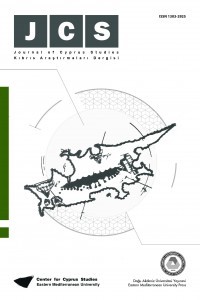Surlariçi Mağusa’nın Mimari Kimliği Üzerine Bir İnceleme
Yapılaşmış çevrenin oluşumunda, kimliğin ve ona bağlı gelişen aidiyet hissinin devam ettirilmesi esas hedeflerdendir. İşte bu nedenledir ki, mimarlar için kimlik ve onun mimarlıktaki kompleks ifadesi en temel açmazlardan biri olmuştur. Hatta, söz konusu açmaz, adaların yapılaşmış çevrelerinde, onların dinamik yapılarına bağlı olarak daha da açık bir şekilde görülür. Ancak, bu kadar önemli olmasına rağmen, aralarında Kıbrıs’ın da olduğu birçok adada, günümüz mimarisi özgün yerel karakterlerle anlam bulamıyor ve kendi özgün kimliğini genellikle devam ettiremiyor. Tüm bunlara karşın, Kıbrıs Adası’ndaki geleneksel mimari doku, kültürel sürdürülebilirlik ve kimlik açısından en iyi imkanları hala daha sunmaya devam etmektedir. Geleneksel evlerde, geleneksel mahallelerde ya da geleneksel çevrelerde yaşayan insanlar, bulundukları yerlere karşı daha kolay aidiyet hissi geliştirebilmektedirler. Bu bağlamda yer, yani çevreye ilişkin özelliklerin öne çıktığı, aidiyet ve kimlik değerlerinin yüksek olduğu geleneksel mimarlık üzerinde durulmaya ve çalışılmaya değerdir. Bu noktadan hareketle, Gazimağusa Surlariçi’ndeki geleneksel evlerin mimari kaliteleri ve karakteristik özellikleri bu çalışmada ele alınmaktadır. Bu bölgede yer alan geleneksel evler, Kıbrıs geleneksel kent evlerinin genel özelliklerini yansıtmakta ve genel mimari kimliği ortaya koymaktadırlar. Evlerin genel özelliklerini ortaya koymak ve sınıflandırmak için gözlem ve analiz metotları kullanılmış, ve Gazimağusa Surlariçi’ndeki geleneksel evlere ilişkin toplam 10 ayırt edici karakteristik özellik belirlenmiştir. Karakteristiklerin bulunup tanımlanmasında, onların günümüzde hala kullanılıyor olmasına önem verilmiş ve böylesi yaşamsal özelliklerin günümüz mimarisinde de kullanılabileceğine dikkat çekilmiştir
Anahtar Kelimeler:
Kimlik, mimari özellikler, konut, Gazimağusa, Surlu Kent
An Exploration of Architectural Identity in the Walled City of Famagusta
Maintaining a sense of belonging and identity is one of the essential goals in the design of a built environment. That is why identity and its complex manifestation in architecture has been one of the main dilemmas ahead for architects. Such difficulty has been even more evident in the case of the built environments of islands due to their dynamic characteristics. Despite its importance, however, contemporary architecture in many islands, including Cyprus, shows little interest in creating meaningful and identifiable environments. Nevertheless, traditional architecture still offers the best solution for Cyprus in terms of cultural sustainability and identity. People who live in traditional buildings and districts more easily feel that some part of the environment belongs to them. Traditional architecture, representing a great deal of place-based experience, is thus worth studying. This study will assess the architectural quality and characteristics of local houses in “the walled city” in Famagusta. Traditional houses in this area demonstrate the identity of architecture in North Cyprus. This study uses observation and analysis to describe and categorize the characteristics of local houses, resulting in 10 identifiable characteristics for houses in the walled city. In finding and defining these characteristics, the study has focused on features that are still in use. Such living characteristics can be used in contemporary architecture as well
Keywords:
Identity, architectural characteristics, housing, Famagusta, Walled City,
___
- Abel, C. (1997). Architecture and Identity: Towards A Global Eco-Culture
- Abel, C. (2000). Architecture and Identity: Responses to Cultural and Technological Change. Routledge.
- Alexander, C., Ishikawa, S., & Silverstein, M. (1977). Pattern Languages. New York: Oxford University Press.
- Alexander, C. (1979). The Timeless Way of Building. New York: Oxford University Press.
- Correa, C. (1983, July). Quest for Identity. In Proceedings of the Seminar: Exploring Architecture in Islamic Cultures (Vol. 1).
- Dixon, J., & Durrheim, K. (2000). Displacing place‐ identity: a discursive approach to locating self and other. British journal of social psychology, 39(1): 27-44.
- Doratlı, N., & Hoşkara, S. O. (2010). A Critical Review on the Revitalization of Historic Urban Centers on the Mediterranean Islands: A Policy Approach, Third World Congress for Middle Eastern Studies (WOCMES) – Panel: Rehabilitating and Revitalizing Mediterranean Historic Centers, 19 – 24 July 2010, Barcelona.
- Sani, R. M. S. (2009). An Inquiry into Iranian Architecture Manifestation of Identity, Symbolism, and Power in the Safavid’s Public Buildings (Doctoral dissertation, Eastern Mediterranean University (EMU)).
- Scott, J. (2002). Mapping the past: Turkish Cypriot narratives of time and place in the Canbulat museum, northern Cyprus. History and Anthropology, 13(3): 217-230.
- Seretis, K. (2005). An Island Divided: Politicised Landscapes, Modern Borders, and Shifting Identities. Journal of Conflict Archaeology, 1(1): 215-233.
- Twigger-Ross, C. L., & Uzzell, D. L. (1996). Place and identity processes. Journal of environmental psychology, 16(3): 205-220.
- Twigger-Ross, C. L., Bonaiuto, M., & Breakwell, G. (2003). Identity theories and environmental psychology. Psychological theories for environmental issues, 203-233.
- Vertovec, S. (2001). Transnationalism and identity. Journal of Ethnic and Migration studies, 27(4): 573-582.
- Wegerhoff, E. (Ed.). (2008). Architecture and Identity (Vol. 9). LIT Verlag Münster.
- Williams, D. R., Patterson, M. E., Roggenbuck, J. W., & Watson, A. E. (1992). Beyond the commodity metaphor: Examining emotional and symbolic attachment to place. Leisure Sciences, 14(1), 29-46.
- ISSN: 1303-2925
- Başlangıç: 2019
- Yayıncı: Doğu Akdeniz Üniversitesi
Sayıdaki Diğer Makaleler
Kuzey Kıbrıs’ta Bilgi ve İletişim Teknolojileri BİT ve E-Devlet Uygulamaları
Mağusa’nın 2300. Yaşı Üzerine Notlar
Turizm Gelişmesinin Enerji Tüketimi Üzerine Etkisini Öngörmek: Kuzey Kıbrıs örneği
Kıbrıs’ ta Lorenzo Warriner Pease
